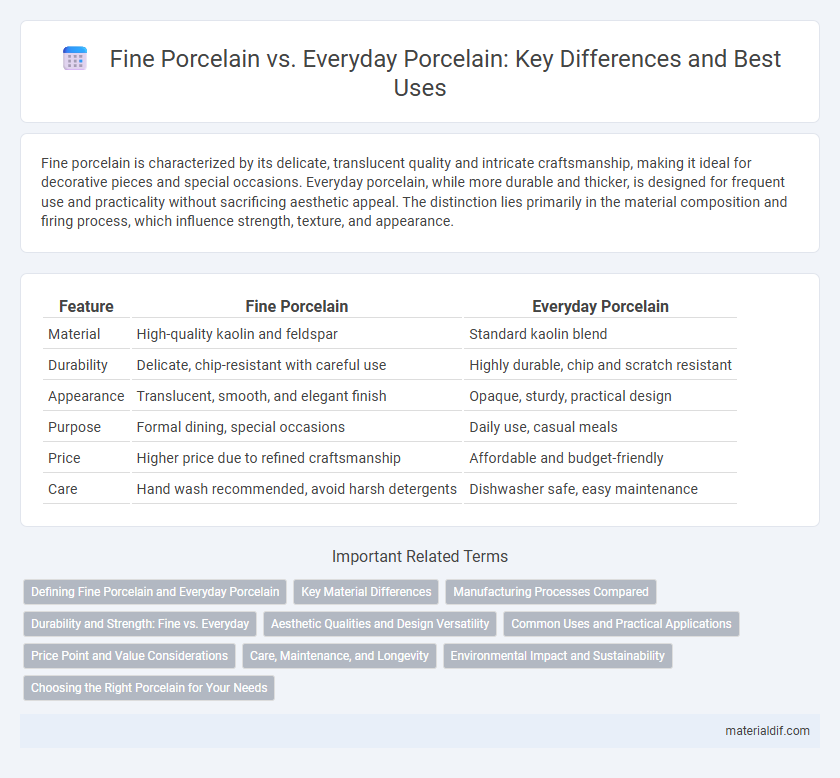Fine porcelain is characterized by its delicate, translucent quality and intricate craftsmanship, making it ideal for decorative pieces and special occasions. Everyday porcelain, while more durable and thicker, is designed for frequent use and practicality without sacrificing aesthetic appeal. The distinction lies primarily in the material composition and firing process, which influence strength, texture, and appearance.
Table of Comparison
| Feature | Fine Porcelain | Everyday Porcelain |
|---|---|---|
| Material | High-quality kaolin and feldspar | Standard kaolin blend |
| Durability | Delicate, chip-resistant with careful use | Highly durable, chip and scratch resistant |
| Appearance | Translucent, smooth, and elegant finish | Opaque, sturdy, practical design |
| Purpose | Formal dining, special occasions | Daily use, casual meals |
| Price | Higher price due to refined craftsmanship | Affordable and budget-friendly |
| Care | Hand wash recommended, avoid harsh detergents | Dishwasher safe, easy maintenance |
Defining Fine Porcelain and Everyday Porcelain
Fine porcelain is characterized by its high-quality kaolin clay, exceptional translucency, and delicate craftsmanship, often used for luxury dinnerware and decorative pieces. Everyday porcelain, made from a blend of clays with higher firing temperatures, offers durability and chip resistance suitable for regular use. The distinction lies in the material composition and intended function, with fine porcelain prioritizing elegance and everyday porcelain focusing on practicality.
Key Material Differences
Fine porcelain is characterized by its high kaolin content, resulting in a denser, more translucent, and durable material with a smoother finish. Everyday porcelain typically contains a higher percentage of feldspar and quartz, making it more opaque and less refined but more affordable and resistant to chips. The firing temperature also varies, with fine porcelain fired at around 1,300degC, enhancing its strength and whiteness compared to everyday porcelain fired at lower temperatures.
Manufacturing Processes Compared
Fine porcelain undergoes a meticulous manufacturing process involving refined kaolin clay, multiple high-temperature firings, and precise shaping techniques to achieve its translucent, delicate finish and superior strength. Everyday porcelain is produced with coarser clay blends and fewer firings, resulting in a more durable, less translucent product suitable for frequent use. The controlled vitrification in fine porcelain manufacturing enhances its density and whiteness, distinguishing it from the more porous texture typical of everyday porcelain.
Durability and Strength: Fine vs. Everyday
Fine porcelain exhibits superior durability and strength due to its higher density and refined firing process, making it resistant to chipping and cracking. Everyday porcelain, while still sturdy, typically contains more inclusions and lower firing temperatures, resulting in less resilience over time. The molecular structure of fine porcelain allows it to withstand thermal shock better, extending its lifespan compared to everyday varieties.
Aesthetic Qualities and Design Versatility
Fine porcelain features a translucent, smooth surface with intricate detailing that elevates its aesthetic qualities, making it highly prized in luxury tableware and decorative art. Everyday porcelain offers greater design versatility with durable, thicker materials that accommodate bold patterns and everyday functionality without compromising style. The delicate craftsmanship in fine porcelain contrasts with the practical, mass-produced appeal of everyday porcelain, catering to different user preferences and occasions.
Common Uses and Practical Applications
Fine porcelain is often used for elegant dinnerware, decorative pieces, and collectible items due to its delicate translucency and refined craftsmanship, making it ideal for formal occasions and display. Everyday porcelain is sturdier and more durable, designed for regular use in kitchens and restaurants, withstanding frequent washing and handling without chipping or cracking. Common applications of everyday porcelain include mugs, plates, and bowls that balance functionality with aesthetic appeal for daily dining needs.
Price Point and Value Considerations
Fine porcelain, often crafted from high-quality kaolin clay and fired at higher temperatures, commands a premium price due to its translucency, durability, and intricate craftsmanship, making it a valuable investment for collectors and luxury dining. Everyday porcelain, typically made from more common materials and produced in larger quantities, is priced affordably to meet practical needs without sacrificing basic functionality and aesthetic appeal. Evaluating price points between fine and everyday porcelain involves weighing long-term value based on intended use, durability, and the level of artistic detail.
Care, Maintenance, and Longevity
Fine porcelain, characterized by its delicate composition and high-quality materials such as kaolin and petuntse, requires gentle hand washing with mild detergents and soft cloths to prevent surface damage and preserve its intricate designs. Everyday porcelain, typically denser and more durable, withstands routine dishwasher use and more rigorous cleaning methods, making it suitable for daily handling and frequent use. Proper care and maintenance enhance the longevity of fine porcelain by minimizing cracks and discoloration, while everyday porcelain offers greater resilience for long-term practicality without sacrificing aesthetic appeal.
Environmental Impact and Sustainability
Fine porcelain, known for its high-quality kaolin clay and meticulous firing process, typically has a higher environmental footprint due to energy-intensive production and longer kiln times. Everyday porcelain uses less refined materials and simpler manufacturing methods, resulting in lower energy consumption and reduced waste generation. Choosing everyday porcelain promotes sustainability by supporting more efficient resource use and minimizing carbon emissions throughout the production cycle.
Choosing the Right Porcelain for Your Needs
Fine porcelain, characterized by its translucency, high firing temperature, and intricate craftsmanship, offers superior durability and elegance ideal for formal dining and collectible pieces. Everyday porcelain, often referred to as vitreous china, provides practical strength and resistance to chipping at a lower cost, making it perfect for daily use and casual settings. Selecting the right porcelain depends on balancing factors such as intended use, budget, and desired aesthetic quality to ensure both functionality and style are met.
Fine Porcelain vs Everyday Porcelain Infographic

 materialdif.com
materialdif.com